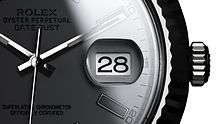Rolex Datejust
|
Rolex Datejust on Jubilee bracelet with Turn-o-graph bezel | |
| Type | Automatic |
|---|---|
| Display | Analog |
| Introduced | 1945 |
The Rolex Oyster Perpetual Datejust is a certified, self-winding chronometer wristwatch manufactured by Rolex. When it was launched in 1945, the Datejust was the first wristwatch with an automatically changing date function.[1][2]
Watch History
The original Datejust model REF: 4467 was only available in 18 karat gold and had a small bubble back winder with a deeply domed back. It also featured a waterproof Oyster case, a fluted bezel, and a signature Jubilee bracelet, making it instantly identifiable as a Rolex.[3]

Over the years, the Datejust movement went through subtle improvements to its features while remaining true to its original design.
It is interesting to note, that the archetypal Datejust reference 1605 from the early to mid 50's and the 31mm Rolex Oyster Speedking and Speedking Precisions (the latter offered in 3 movements grades, one being 3.5 hunter, manual wind) from the early to mid 40's had a significant influence on Rolexes contemporary, but classic Datejust reference 116200, when configured with its silver 'Art Deco' dial and luminous Arabic numerals and minute chapters. However, the Art Deco dial has Arabic numerals, while the 1605 reference Datejust used indices/ baton appliques. Most 1605 reference dials were silver, however black was on offer, but rare for the time. It is also noted that the contemporary reference uses Arabic numerals, just like the Speedking model from the mid to late 30's and the Speedking Precision from the early 40's did. These Speedking models were often brought by British and Canadian fighter pilots and other servicemen during WWII. During liberation of POW's from concentration camps in Europe Rolex gave a number of British POW's each a Rolex Oyster Speedking Precision 10.5 hunter, with tropical dial, telling them to pay when and if they could. If one looks for them, the history and resemblance of these early pieces are still visible in the silver Art Deco dial Datejust 116200 of today[4]
Several years after its debut, In 1954, Rolex added the now famous “Cyclops Lens” as a major update.[5]
The Datejust is offered with two classic Rolex bracelets: the jubilee and the oyster. The original Datejust was launched with a case size of 36mm. Later, however, ladies' and mid-sized versions became available. The Turn-o-Graph model was introduced in 1955 as an award given to US Air Force pilots returning from combat missions. It featured a rotating bezel marked to 60 minutes, which can be used to measure time intervals. Datejusts of this type have been nicknamed "Thunderbirds". Chuck Yeager wore one of these models when he broke the sound barrier.[1] This would be the basis for the Rolex Explorer (designed for Sir Edmund Hillary's Mount Everest expedition), the Rolex Submariner, and the Rolex Sea Dweller.[2]
In 2009, the Rolex Oyster Perpetual Datejust II was released. At 41mm in diameter (excluding the crown) its case is bigger than the original Datejust.[6]
In 2016, the Rolex Oyster Perpetual Datejust 41mm was released. The watch comes in two-tone stainless steel and 18k yellow or 18k everose gold (Rolex's version of rose gold). The 2016 41mm Datejust is on a jubilee bracelet. While the Datejust 41 has a similar-sized 41mm diameter case as the Datejust II, the Datejust 41 has smaller indexes and a thinner bezel compared to the Datejust II.[7]
Rolex connoisseurs believe that Datejust 41 was released to create a more elegant, proportionate, and in a roots sense, traditional appearance, something they thought Datejust II arguably failed to evolve from the classic, original 36mm Datejust.[8]
Though there has been a general trend toward larger sized watches from 2001 spurring Rolex to increase the size of the Datejust in 2009, there is some belief watch sizes are on the decrease. Rolex still advertises the current 36mm Datejust as a men's watch and many purists believe it is the standard and indeed shall always remain the classic Rolex.[9]
In popular culture
Several of the male characters in the movie The Informers wear the Rolex Datejust. In the movie American Psycho, Patrick Bateman wears the Rolex Datejust 16013, two tone yellow gold with a vertical lined tapestry gold coloured dial. Both are adaptations of Bret Easton Ellis novels.
Paul Newman is seen wearing a Datejust in the film The Color of Money.
Harrison Ford sports a Datejust 36mm in the 1980's movie Frantic. It had a white Roman numeral dial, a white gold bezel and steel jubilee bracelet and case.
Bill Murray wears a Datejust with a black dial in the movie Lost in Translation.
Presidents Bill Clinton, Eisenhower and Ronald Reagan all wore the Rolex Datejust while in office. Eisenhower's' Datejust had a white Roman numeral dial, a stainless steel engine turned bezel and a steel jubilee bracelet and steel case.
British Priminister Winston Churchill who had a rather large wrist wore the first Datejust 36mm model while in office during WWII.
References
- 1 2 Edwards, Frank (1997). Wristwatches: A Connoisseur's Guide. New York: Firefly. p. 160. ISBN 978-1-55209-083-1.
- 1 2 Brozek, John E. (2002). The Rolex Report: An Unauthorized Reference Book For The Rolex Enthusiast. New York: Infoquest. p. 288. ISBN 978-0-9723133-0-8.
- ↑ "Rolex Datejust: A casual Luxury Watch with Legendary Status.". Buy & Sell | Pre-owned Certfied Luxury Watches - Rolex, Cartier and many More. 2016-12-15. Retrieved 2016-12-27.
- ↑ https://www.hodinkee.com/articles/rolex-datejust-review
- ↑ "WatchTime Wednesday: The History of the Rolex Datejust - Monochrome-Watches". Monochrome Watches. 2014-08-27. Retrieved 2016-12-27.
- ↑
- ↑
- ↑
- ↑ http://timeandtidewatches.com/in-depth-twenty-four-months-with-a-rolex-datejust